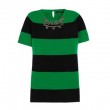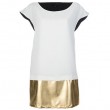Once upon a time, visiting an art gallery used to mean perusing delicate brush strokes and admiring the artists’ use of colours. These days? You’re just as likely to find yourself standing in front of some animal body part displayed within a perspex box, wondering whether you mistook the abattoir for a gallery. Over the latter part of the 20th century, the surge in intriguing contemporary artists and the divisive, non-traditional work they produce might suggest that creative success has become as much the result of the distinctiveness of their identities as it is the technical quality of their artistic output.
From the enigmatic ‘anonymous’ street artist Banksy to the unpredictable Tracey Emin, you’ll probably be able to name more than a few idiosyncratic contemporary artists. In fact, many people might tell you that Grayson Perry is famous for cross-dressing before they could begin to describe any of his ceramic vases. It is easy to understand why contemporary artists might be tempted to use intrigue to drive sales and generate publicity, turning aspects of a quirky personality to their commercial advantage.
Damien Hirst’s retrospective at the Tate Modern in 2012 provided a prime example of this: having been taken out of your comfort zone thanks to a series of predictably grotesque installations, you found yourself in a rather sinister gift shop where plastic skulls worth £36,800 were amongst the merchandise on offer. More recently, the erection of his statue Verity in Ilfracombe served as a reminder to us all that Hirst doesn’t follow the crowd in his approach to art. The statue of a female figure stands 65 feet tall, with her skin peeled back to reveal her innards. The meaning? Verity symbolises truth and justice in the modern world. The general perception amongst the locals of the North Devonshire seaside resort, however, has been one of ‘gratuitous insult.’
This may not be such a revelation. Looking back, creative genii have always had a tendency to deviate from the norm. The volatile Caravaggio fled Rome in 1606 after a heated tennis match culminated in a murder, while Van Gogh is said to have cut off his own ear following an altercation with fellow artist Gauguin, although it is now questioned whether it was in fact Gauguin that cut of Van Gogh’s ear. Either way, the severed ear can likely be attributed to artistic fervour.
During the 15th, 16th and 17th centuries - when some of the most technically revered artists such as Raphael and Titian were painting - there was a strong emphasis on portraying images with accuracy and precision. And today? With the invention of the camera, almost anyone can pursue their artistic ambitions - is it creativity for creativity’s sake? Perhaps the best-know contemporary artists are not most technically capable, but rather the most inventive and driven to succeed.
A quality which is arguably apparent in almost all contemporary artists is a strong sense of self-worth. According to video artist Charles Atlas: “One difference between artists and ordinary people is that artists have big egos. In some cases, it’s the only difference.” They seem to be unphased by criticism, ruthlessly determined and bear an unwavering belief in their own talent. Not to mention that with the rise of social media, the old-fashion coteries of critics and wealthy art fans are no longer necessarily the ones that artists need to please or appeal to.
Changes in how we communicate mean that artists can reach out to their fans via social networks; Artstack - a new social media channel devoted entirely to sharing and commenting on art - is one of many examples of how this trend has occurred. Although there is no reason to believe that this high sense of self-worth has not always prevailed amongst artistic minds. After all, it was Salvador Dali who - long before the rise of the internet - stated that:“When I paint, the ocean roars. Others merely paddle in their bath.”
 Twitter
Twitter Facebook
Facebook Email
Email Sarah is currently working in advertising having recently graduated from Oxford. Her loves in life include music, art, foreign politics and travelling... but she's always looking for new ones to add to the list.
Sarah is currently working in advertising having recently graduated from Oxford. Her loves in life include music, art, foreign politics and travelling... but she's always looking for new ones to add to the list.










